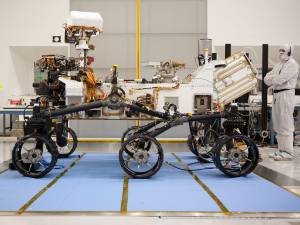The Red Planet is on all our minds here at the Museum as we prepare for an exciting live-stream of the landing of NASA’s Curiosity rover on Mars in the early hours of Monday 6 August.
It'll be make, and hopefully not break, time for the largest rover that NASA has ever attempted to land on another planet, as the Mini Cooper-sized Curiosity rover (image left, credit: NASA/JPL-Caltech) reaches the nail-biting conclusion of its journey to Mars and begins its mission to find evidence for a life-supporting environment on the surface.
We'll be live-linking to Mission Control in California and the audience will be able put their questions to NASA's scientists during this once-in-a-lifetime event. And, if we are lucky, we may even see the first images transmitted back to Earth from Curiosity.
Also on hand during our live-link will be 3 former mission scientists and Mars experts, Dr Peter Grindrod from University College London, Dr Matthew Balme from Open University, and Dr Joseph Michalski from the Museum to talk us through planetary exploration, the technology behind NASA’s latest Martian endeavour, and the purpose of Curiosity’s mission.
Tickets are sold out but you can follow the #msl tag on Twitter to keep in touch with global coverage and experience the tension as NASA goes through the 7 minutes of terror of the landing.
Gale Crater, where Curiosity is destined to land, is known from other Mars missions to have been wet and contain clay minerals. Clays, other phyllosillicates and sulphates are known to form under liquid water conditions with life-supporting pH ranges. The wet environment at the landing site is long gone but the chemical signs of what could have been a habitable environment - and the geological context for it - could still be detectable and this is what Curiosity’s 10 scientific instruments will be studying during its stay on Mars.
The intended landing area for NASA's Curiosity rover in Gale Crater is known to have been wet in the past. Image Credit: NASA/JPL-Caltech/ASU
Curiosity's Seven Minutes of Terror
So, come Monday morning, it'll be fingers crossed that Curiosity lands safely and goes on to be as wildly successful as Opportunity and Spirit, NASA's last two rovers to journey across the surface of Mars ...
See what other After Hours events are happening at the Museum
Follow the latest news about Curiosity's mission via #msl on Twitter
Unable to join us early on Monday morning? Joseph will also be with the Nature Live team later in the day at 12:30 and 14:30 to give two free talks on the mission, so drop into the Museum's Attenborough Studio for Destination Mars.
P.S. Rose is currently on annual leave, but will be back soon to bring you What's new at the Museum.




